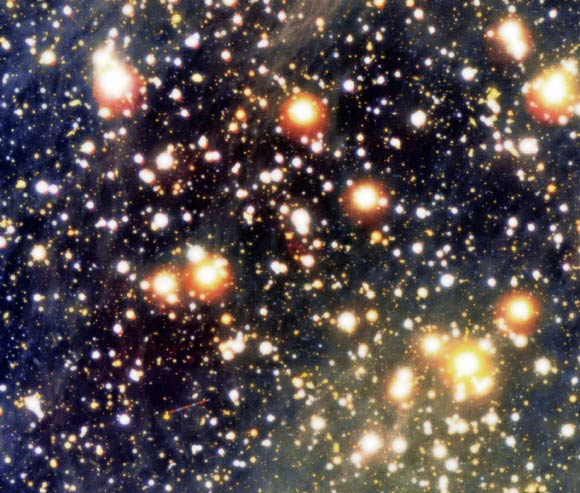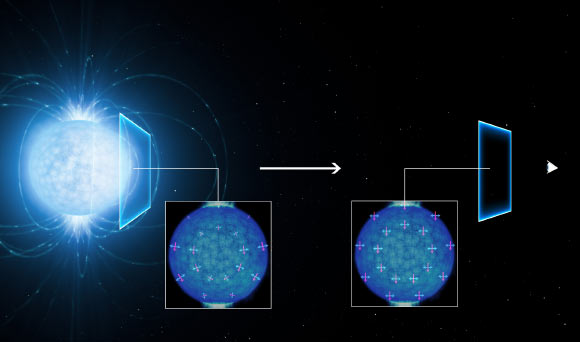By studying the light emitted from the very dense and strongly magnetic neutron star RX J1856.5-3754, a team of astronomers has found the strongest observational indications yet of vacuum birefringence, a strange quantum effect first predicted nearly 80 years ago.

Color composite photo of the sky field around RX J1856.5-3754 and the related cone-shaped nebula. RX J1856.5-3754 is exactly in the centre of the image. The trail of an asteroid is seen in the field with intermittent blue, green and red colors. Image credit: ESO.
Neutron stars are the very dense remnant cores of massive stars that have exploded as supernovae at the ends of their lives.
They also have extreme magnetic fields — billions of times stronger than that of the Sun — that permeate their outer surface and surroundings. These fields are so strong that they even affect the properties of the empty space around the star.
Normally a vacuum is thought of as completely empty, and light can travel through it without being changed.
But in quantum electrodynamics (QED), the quantum theory describing the interaction between photons and charged particles such as electrons, space is full of virtual particles that appear and vanish all the time.
Very strong magnetic fields can modify this space so that it affects the polarization of light passing through it.
“According to QED, a highly magnetized vacuum behaves as a prism for the propagation of light, an effect known as vacuum birefringence,” said team member Dr. Roberto Mignani, from INAF Milan in Italy.
Among the many predictions of QED, however, vacuum birefringence so far lacked a direct experimental demonstration.
Attempts to detect it in the laboratory have not yet succeeded in the 80 years since it was predicted in by Werner Heisenberg and Hans Heinrich Euler.
“This effect can be detected only in the presence of enormously strong magnetic fields, such as those around neutron stars,” said team member Dr. Roberto Turolla, from the University of Padua in Italy.
“This shows, once more, that neutron stars are invaluable laboratories in which to study the fundamental laws of nature.”

This artist’s view shows how the light coming from the surface of a strongly magnetic neutron star (left) becomes linearly polarized as it travels through the vacuum of space close to the star on its way to the observer on Earth (right). The polarization of the observed light in the extremely strong magnetic field suggests that the empty space around the neutron star is subject to a quantum effect known as vacuum birefringence. The magnetic and electric field directions of the light rays are shown by the red and blue lines. Image credit: L. Calçada / ESO.
The team used the FORS2 instrument on ESO’s Very Large Telescope (VLT) at the Paranal Observatory, Chile, to observe RX J1856.5-3754, a neutron star approximately 401 light-years away in the constellation Corona Australis.
RX J1856.5-3754 belongs to a class of seven radio-quiet isolated neutron stars, a.k.a. the ‘Magnificent Seven,’ attracted the interest from the neutron star community soon after their discovery in the 1990s.
After careful analysis of the VLT data, the astronomers detected linear polarization — at a significant degree of around 16% — that they say is likely due to the boosting effect of vacuum birefringence occurring in the area of empty space surrounding RX J1856.5-3754.
“This is the faintest object for which polarization has ever been measured,” said team member Dr. Vincenzo Testa, from INAF Rome.
“The high linear polarization that we measured with the VLT can’t be easily explained by our models unless the vacuum birefringence effects predicted by QED are included,” Dr. Mignani added.
“This VLT study is the very first observational support for predictions of these kinds of QED effects arising in extremely strong magnetic fields,” said team member Dr. Silvia Zane, from University College London, UK.
The findings were published online Nov. 2, 2016 in the Monthly Notices of the Royal Astronomical Society (arXiv.org preprint).
_____
Roberto P. Mignani et al. 2017. Evidence for vacuum birefringence from the first optical-polarimetry measurement of the isolated neutron star RX J1856.5-3754. MNRAS 465 (1): 492-500; doi: 10.1093/mnras/stw2798





![The image shows NGC 1866 superimposed with a false color image from the MUSE data cube, where the ionized shell of the planetary nebula Ka LMC 1 is seen as a red ring. The grayscale insets illustrate the different size of the ionized shells of singly ionized nitrogen [N II] and doubly ionized oxygen [O III]. The magnified Hubble image near the center of the ring reveals the presence of a pale blue star -- most probably the hot central star of Ka LMC 1. Image credit: AIP / M.M. Roth / NASA / ESA / Hubble.](https://cdn.sci.news/images/2025/11/image_14348-Ka-LMC-1-104x75.jpg)

